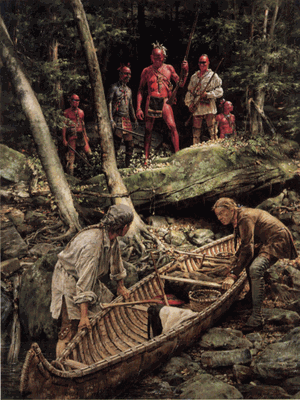  
The treaty of Ft. Stanwix in 1768 ceded all land east of the Ohio River to the English. The land to the west of the great river was to remain native forever. Almost immediately Pennsylvania and Virginia scurried for control of the newly open territory. Both provinces sent settlers to stake claims in the Ohio country. The military, fur trading companies and even missionaries all tried to snatch a part of the new land. Each was taking advantage of the other. Often the zeal for land ignored the laws of treaties. Some settlers even went so far as to attack bands of natives in hopes of precipitating yet another war, thereby extending the frontier further west.
For the natives, the clear-cut alliances of the preceding decade gave way to a confusing array of competition and deceit. The demise of Pontiac's war left many tribes disillusioned. The Indians split into factions. Many wished to continue resisting the whites while others only wanted peace. Some attempted to stem the flow of whites in the council house while others moved west. To complicate matters further, dislocated native bands from the east brought even more pressure to the valley. The Ohio country had become a bubbling cauldron of self-interest and greed.
In 1773 Sir William Johnson warned that the Shawnee were "in a state of alarm over the large number of people from Virginia who were settling in this territory". Sir WIlliams's words were ignored and tensions rose as the flood of whites continued. In the early months of 1774 a party of surveyors under Colonel Preston entered the country. Close on their heels were more settlement parties including George Rogers Clark and Michael Cresap.
The native towns of the Ohio country typically centered on one of the many streams and rivers criss-crossing the plains. The valleys cut by these streams provided the best land and proved irresistible to the whites. It was inevitable that traveling parties would come into contact with one another. Travelers had to remain on their guard at all times. One can well imagine the cautious approach made by many a white settler or hunter. Merely coming upon another person was cause for suspicion. Even the color of one's skin was not a certain means of identifying a friend from foe. Two white settlers, having chosen a likely site for a home, drag their canoe to shore; no doubt pleased with their location. In a glance, what once seemed like a time for joy suddenly and dramatically changes. On the overhanging rocks above, from the depths of the forest, materialize the fearsome looking warriors. Chance meetings between the two parties were always unpredictable, emphasizing that ever-present thin line between life and death.
Image size: 27" x 18 1/2"
Edition size: 950 S/N
|